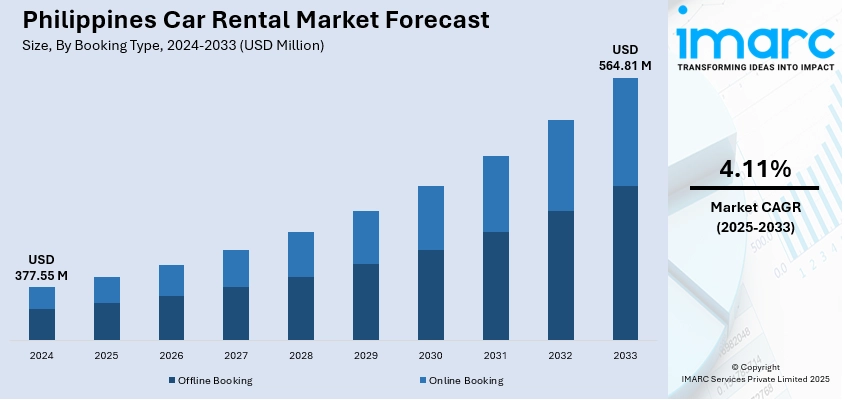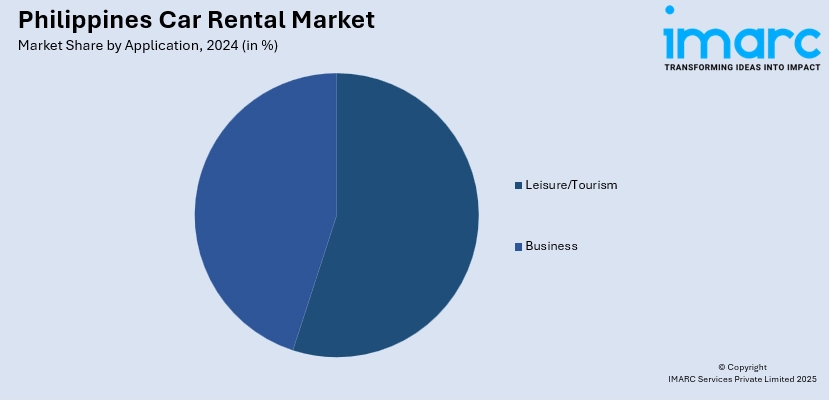
Philippines Car Rental Market Size, Share, Trends, and Forecast by Booking Type, Rental Length, Vehicle Type, Application, End-User, and Region, 2025-2033
Philippines Car Rental Market Overview:
The Philippines car rental market size reached USD 377.55 Million in 2024. The market is projected to reach USD 564.81 Million by 2033, exhibiting a growth rate (CAGR) of 4.11% during 2025-2033. The market is experiencing notable development, driven by expanding tourism, urban mobility needs, and demand for seamless travel experiences. Digital booking platforms, flexible rental durations, and a diverse fleet of vehicle types are shaping consumer preferences. Operators are emphasizing service quality and regional outreach to strengthen market positioning. Collaboration with travel partners and enhanced customer support are further enhancing accessibility across key Philippine destinations. These evolving dynamics collectively influence the growth of the Philippines car rental market share.
|
Report Attribute
|
Key Statistics
|
|---|---|
|
Base Year
|
2024
|
|
Forecast Years
|
2025-2033
|
|
Historical Years
|
2019-2024
|
| Market Size in 2024 | USD 377.55 Million |
| Market Forecast in 2033 | USD 564.81 Million |
| Market Growth Rate 2025-2033 | 4.11% |
Philippines Car Rental Market Trends:
Influence of Tourism and Fleet Diversification
Tourism remains a major engine for the Philippines’ car rental sector, with a rising number of visitors seeking flexible and reliable transportation options across various destinations. Island-hopping, heritage tours, and regional travel have driven demand for a more diverse fleet, including sedans for urban trips and SUVs or multi-purpose vehicles suited to mixed terrains. In March 2024, international tourist arrivals were exceptionally strong, reinforcing robust demand for rental mobility across the country. As tourists explore multiple islands and rural areas, the appeal of renting vehicles capable of handling varied road conditions strengthens. Simultaneously, demand from domestic travelers during long weekends and festive seasons also contributes to utilization rates. Rental operators are responding by expanding model variety and aligning supply with seasonal travel patterns. These efforts help ensure availability, while meeting evolving user expectations for comfort and functionality. Collectively, these shifts underscore how tourism-driven demand is a vital force shaping Philippines car rental market trends.

To get more information on this market, Request Sample
Expansion of Online Booking and App-Based Rentals
The Philippine car rental market is increasingly adopting digital channels as a central source of customer satisfaction and business effectiveness. Online reservation processes, mobile apps, and comparison functionalities are streamlining the rental experience, enabling users to compare, book, and pay easily. Such digitization aligns with consumer behavior changes where ease, transparency, and responsiveness are highly appreciated and enhance a more agile, reactive model of service. Improved infrastructure, such as better road connectivity and airport access, is also facilitating broader expansion of rental services in urban and provincial regions. In 2025, the adoption of digital car rental sites continued to gain traction as people became increasingly confident in the use of cashless and app-based transactions. Rental operators are gaining a deeper understanding of usage patterns, allowing them to make more intelligent decisions about fleet management and the implementation of dynamic pricing models. This digital movement is reshaping service delivery and accessibility for corporate and recreational customers alike. These trends are fueling the Philippines car rental market growth.
Growth of Sustainable Options and Regulatory Support
Sustainability and regulatory convergence are becoming increasingly important factors in the development of the Philippines' auto rental sector. Environmental objectives, alongside government-wide transport modernization programs, are compelling rental operators to update their fleets to comply with new efficiency and emission requirements. Public policy is increasingly calling for lower-carbon options as well as promoting cleaner technologies in transport. In 2024, national agencies reinforced the enforcement of the Public Utility Vehicle Modernization Program, marking a strong move towards greener, safer, and more standardized mobility. Although rental cars are not the main target of the program, its impact is taking a bearing on private sector choices, especially in transport nodes and cities. This move is encouraging operators to consider hybrid and low-emission cars as part of long-term fleet strategies. Moreover, the increasing cost of fuel and customer demand for green solutions are favoring this shift. The trend indicates a step-by-step but consistent coordination of the industry with wider goals in sustainability, which is securing the future of operations as well as facilitating compliance with upcoming regulations nationwide.
Philippines Car Rental Market Segmentation:
IMARC Group provides an analysis of the key trends in each segment of the market, along with forecasts at the country and regional levels for 2025-2033. Our report has categorized the market based on booking type, rental length, vehicle type, application, and end-user.
Booking Type Insights:
- Offline Booking
- Online Booking
The report has provided a detailed breakup and analysis of the market based on the booking type. This includes offline booking and online booking.
Rental Length Insights:
- Short Term
- Long Term
A detailed breakup and analysis of the market based on the rental length have also been provided in the report. This includes short term and long term.
Vehicle Type Insights:
- Luxury
- Executive
- Economy
- SUVs
- Others
The report has provided a detailed breakup and analysis of the market based on the vehicle type. This includes luxury, executive, economy, SUVs, and others.
Application Insights:

- Leisure/Tourism
- Business
A detailed breakup and analysis of the market based on the application have also been provided in the report. This includes leisure/tourism and business.
End-User Insights:
- Self-Driven
- Chauffeur-Driven
The report has provided a detailed breakup and analysis of the market based on the end-user. This includes self-driven, and chauffeur-driven.
Regional Insights:
- Luzon
- Visayas
- Mindanao
The report has also provided a comprehensive analysis of all the major regional markets, which include Luzon, Visayas, and Mindanao.
Competitive Landscape:
The market research report has also provided a comprehensive analysis of the competitive landscape. Competitive analysis such as market structure, key player positioning, top winning strategies, competitive dashboard, and company evaluation quadrant has been covered in the report. Also, detailed profiles of all major companies have been provided.
Philippines Car Rental Market News:
- May 2025: Toyota RentαCar, the official car rental service of Toyota Motor Philippines, has partnered with JoyRide, the country’s leading mobility superapp, to offer seamless long‑term car rental options. Users can now conveniently book a wide range of vehicles including sedans, SUVs, and vans, for self‑drive or chauffeur‑driven use directly through the JoyRide Superapp. Available initially in Metro Manila, this collaboration enhances accessibility and flexibility for travelers, particularly those arriving at key terminals or planning multi-day and multi-stop journeys across the Philippines.
Philippines Car Rental Market Report Coverage:
| Report Features | Details |
|---|---|
| Base Year of the Analysis | 2024 |
| Historical Period | 2019-2024 |
| Forecast Period | 2025-2033 |
| Units | Million USD |
| Scope of the Report |
Exploration of Historical Trends and Market Outlook, Industry Catalysts and Challenges, Segment-Wise Historical and Future Market Assessment:
|
| Booking Types Covered | Offline Booking, Online Booking |
| Rental Lengths Covered | Short Term, Long Term |
| Vehicle Types Covered | Luxury, Executive, Economy, SUVs, Others |
| Applications Covered | Leisure/Tourism, Business |
| End-Users Covered | Self-Driven, Chauffeur-Driven |
| Regions Covered | Luzon, Visayas, Mindanao |
| Customization Scope | 10% Free Customization |
| Post-Sale Analyst Support | 10-12 Weeks |
| Delivery Format | PDF and Excel through Email (We can also provide the editable version of the report in PPT/Word format on special request) |
Key Questions Answered in This Report:
- How has the Philippines car rental market performed so far and how will it perform in the coming years?
- What is the breakup of the Philippines car rental market on the basis of booking type?
- What is the breakup of the Philippines car rental market on the basis of rental length?
- What is the breakup of the Philippines car rental market on the basis of vehicle type?
- What is the breakup of the Philippines car rental market on the basis of application?
- What is the breakup of the Philippines car rental market on the basis of end-user?
- What is the breakup of the Philippines car rental market on the basis of region?
- What are the various stages in the value chain of the Philippines car rental market?
- What are the key driving factors and challenges in the Philippines car rental market?
- What is the structure of the Philippines car rental market and who are the key players?
- What is the degree of competition in the Philippines car rental market?
Key Benefits for Stakeholders:
- IMARC’s industry report offers a comprehensive quantitative analysis of various market segments, historical and current market trends, market forecasts, and dynamics of the Philippines car rental market from 2019-2033.
- The research report provides the latest information on the market drivers, challenges, and opportunities in the Philippines car rental market.
- Porter's five forces analysis assist stakeholders in assessing the impact of new entrants, competitive rivalry, supplier power, buyer power, and the threat of substitution. It helps stakeholders to analyze the level of competition within the Philippines car rental industry and its attractiveness.
- Competitive landscape allows stakeholders to understand their competitive environment and provides an insight into the current positions of key players in the market.
Need more help?
- Speak to our experienced analysts for insights on the current market scenarios.
- Include additional segments and countries to customize the report as per your requirement.
- Gain an unparalleled competitive advantage in your domain by understanding how to utilize the report and positively impacting your operations and revenue.
- For further assistance, please connect with our analysts.
 Request Customization
Request Customization
 Speak to an Analyst
Speak to an Analyst
 Request Brochure
Request Brochure
 Inquire Before Buying
Inquire Before Buying




.webp)




.webp)












